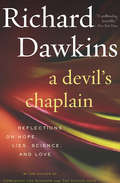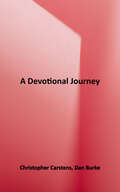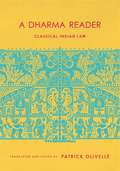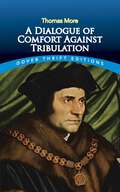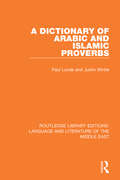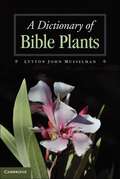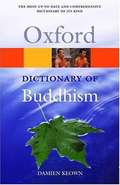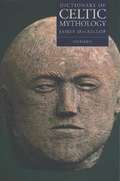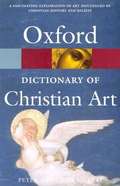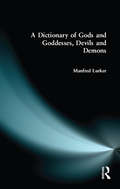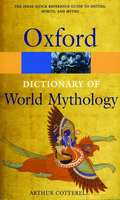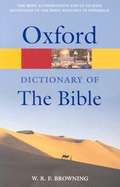- Table View
- List View
A Devil's Chaplain: Reflections on Hope, Lies, Science, and Love
by Richard DawkinsEssays on morality, mortality, and much more from the New York Times–bestselling author of The Selfish Gene and The God Delusion. This early collection of essays from renowned evolutionary biologist Richard Dawkins is an enthusiastic declaration, a testament to the power of rigorous scientific examination to reveal the wonders of the world. In these essays, Dawkins revisits the meme, the unit of cultural information that he named and wrote about in his groundbreaking work, The Selfish Gene. Here also are moving tributes to friends and colleagues, including a eulogy for novelist Douglas Adams, author of The Hitchhiker&’s Guide to the Galaxy; correspondence with fellow biologist Stephen Jay Gould; commentary on the events of 9/11; and visits with the famed paleoanthropologists Richard and Meave Leakey at their African wildlife preserve. Ending with a vivid note to Dawkins&’s ten-year-old daughter, reminding her to remain curious, ask questions, and live the examined life, A Devil&’s Chaplain is a fascinating read by &“a man of firm opinions, which he expresses with clarity and punch&” (Scientific American).
A Devotional Journey into the Mass: How Mass Can Become a Time of Grace, Nourishment, and Devotion
by Christopher CarstensIf you're unhappy because the Mass has become for you routine - or even tedious - these pages are for you. They teach you eight simple ways to make your every Mass a joyful time of piety and intense devotion. Explaining the spiritual meanings behind the signs and symbols, words and actions of the Mass, author Christopher Carstens teaches you spiritually-enriching ways to enter the church building, make the Sign of the Cross, pray the Opening Prayer, listen to the Readings, prepare your soul at the Offertory, participate in the Eucharistic Prayer, receive Communion, and even respond to the Dismissal. Soon - with the help of author Carstens wise suggestions - you will be surprised to find each Eucharistic Celebration a fountain of peace for you, a profound refreshment for your soul. Among other things you'll learn from these pages: - The meaning of the "sacramental principle" if you don't understand it, then Mass is almost surely flat for you. - How each element of the Liturgy has a sacramental quality about it, and can be for you a grace-filled encounter with Jesus. - How to transform your prayers at Mass into a conversation with God? - Why silence - both within the liturgy and outside of it - is a necessary element of that conversation with God. - There's a proper spiritual way to make the Sign of the Cross (do you know what it is?). - How the Creed can be for you the highpoint of the Liturgy of the Word. - Why, during the collection, you should also explicitly offer Christ your heart. - The best way in the Mass to participate in Jesus' saving work: do you know what it is? - What you should desire in order to receive the Eucharist most efficaciously (and what that desire presupposes in you). - Coming and going through the church doors: what, each time, it should mean for you spiritually. Plus, at the end of each chapter, a list of action items for the next time you go to Mass, and much, much more to awaken in you the bright spirit of joyful devotion that we are all called to have at Mass.
A Dharma Reader: Classical Indian Law
by Patrick OlivelleWhether defined by family, lineage, caste, professional or religious association, village, or region, India's diverse groups did settle on an abstract concept of law in classical times. How did they reach this consensus? Was it based on religious grounds or a transcendent source of knowledge? Did it depend on time and place? And what apparatus did communities develop to ensure justice was done, verdicts were fair, and the guilty were punished?Addressing these questions and more, A Dharma Reader traces the definition, epistemology, procedure, and process of Indian law from the third century B.C.E. to the middle ages. Its breadth captures the centuries-long struggle by Indian thinkers to theorize law in a multiethnic and pluralist society. The volume includes new and accessible translations of key texts, notes that explain the significance and chronology of selections, and a comprehensive introduction that summarizes the development of various disciplines in intellectual-historical terms. It reconstructs the principal disputes of a given discipline, which not only clarifies the arguments but also relays the dynamism of the fight. For those seeking a richer understanding of the political and intellectual origins of a major twenty-first-century power, along with unique insight into the legal interactions among its many groups, this book offers conceptual detail, historical precision, and expository illumination unlike any other volume.
A Dharma Reader: Classical Indian Law (Historical Sourcebooks in Classical Indian Thought)
by Patrick OlivelleWhether defined by family, lineage, caste, professional or religious association, village, or region, India's diverse groups did settle on a concept of law in classical times. How did they reach this consensus? Was it based on religious grounds or a transcendent source of knowledge? Did it depend on time and place? And what apparatus did communities develop to ensure justice was done, verdicts were fair, and the guilty were punished?Addressing these questions and more, A Dharma Reader traces the definition, epistemology, procedure, and process of Indian law from the third century B.C.E. to the middle ages. Its breadth captures the centuries-long struggle by Indian thinkers to theorize law in a multiethnic and pluralist society. The volume includes new and accessible translations of key texts, notes that explain the significance and chronology of selections, and a comprehensive introduction that summarizes the development of various disciplines in intellectual-historical terms. It reconstructs the principal disputes of a given discipline, which not only clarifies the arguments but also relays the dynamism of the fight. For those seeking a richer understanding of the political and intellectual origins of a major twenty-first-century power, along with unique insight into the legal interactions among its many groups, this book offers exceptional detail, historical precision, and expository illumination.
A Diabolical Voice: Heresy and the Reception of the Latin "Mirror of Simple Souls" in Late Medieval Europe (Medieval Societies, Religions, and Cultures)
by Justine L. TrombleyIn A Diabolical Voice, Justine L. Trombley traces the afterlife of the Mirror of Simple Souls, which circulated anonymously for two centuries in four languages, though not without controversy or condemnation. Widely recognized as one of the most unusual and important mystical treatises of the late Middle Ages, the Mirror was condemned in Paris in 1310 as a heretical work, and its author, Marguerite Porete, was burned at the stake. Trombley identifies alongside the work's increasing positive reception a parallel trend of opposition and condemnation centered specifically around its Latin translation. She's discovered fourteenth- and fifteenth-century theologians, canon lawyers, inquisitors, and other churchmen who were entirely ignorant of the Mirror's author and its condemnation and saw in the work dangerous heresies that demanded refutation and condemnation of their own. Using new evidence from the Mirror's largely overlooked Latin manuscript tradition, A Diabolical Voice charts the range of negative reactions to the Mirror, from confiscations and physical destruction to academic refutations and vicious denunciations of its supposedly fiendish doctrines. This parallel story of opposition shows how heresy remained an integral part of the Mirror's history well beyond the events of 1310, revealing how seriously churchmen took Marguerite Porete's ideas on their own terms, in contexts entirely removed from Marguerite's identity and her fate. Emphasizing the complexity of the Mirror of Simple Souls and its reception, Trombley makes clear that this influential book continues to yield new perspectives and understandings.
A Dialectical Journey through Fashion and Philosophy
by Eun Jung KangThis book takes an in-depth look at the integration of fashion and philosophy. It challenges the deeply rooted prejudice or misconception that fashion is a field limited to body-oriented and appearance-related themes and practices. It also reveals that fashion is intermeshed with distinctively modern issues that belong to the realm of the mind as well as the body. In doing so, it refashions philosophy and philosophizes fashion, which ultimately amount to the same thing. The book argues that while the philosophization of fashion can give a clearer understanding of some esoteric areas of philosophy and fashion’s close connection to modern societies and politics, it also shows that philosophy can assist in redeeming fashion from the objective, bodily world, positioning it as an indispensable part of the humanities. This is because fashion manifests critical aspects of human culture in our time, and is an expression of the zeitgeist, which is interwoven with the unfolding of history. This book will be highly relevant to students and researchers in fashion studies who are looking for the theoretical underpinnings and insights for their own work. It will also be of keen interest to scholars in the field of philosophy who are seeking to apply philosophical concepts to both everyday life and our empirical world.
A Dialogue of Comfort Against Tribulation (Dover Thrift Editions)
by Thomas More"I die the King's good servant, but God's first," declared Sir Thomas More from the scaffold upon his 1535 execution for treason. Condemned to death for his refusal to acknowledge Henry VIII as the Supreme Head of the Church of England, More spent his final months in the Tower of London, writing this message of hope in the face of suffering. The noted Renaissance humanist cast his work of political thought and spiritual reflection in the form of a fictional dialogue between a young man and his dying uncle. Set in sixteenth-century Hungary during the Ottoman conquests, the colloquy voices the youth's anguish at the impending invasion and the elder's words of solace. More offers a reflection of his own dire circumstances as well as a powerful statement of his conviction that God is a Christian's only comfort. A penetrating exploration of the fleeting nature of pleasure, the essence of worldly power, and Christ's redemptive power, this book constitutes an enduring legacy of faith.
A Dialogue on Personal Identity and Immortality
by John R. Perry"Perry's excellent dialogue makes a complicated topic stimulating and accessible without any sacrifice of scholarly accuracy or thoroughness. Professionals will appreciate the work's command of the issues and depth of argument, while students will find that it excites interest and imagination. " -- David M. Rosenthal, CUNY, Lehman College
A Diamond in the Darkness
by Veni RajThen one day Bahá'í teachers came to his village with a Great Message and things began to happen not only for the village but for Liaz as well. This true and inspiring story, generously illustrated by Tushar Kanti-Paul, will be enjoyed by children, youth and adults, as well.
A Diary of Private Prayer
by John BaillieWith over a million copies in print, John Baillie’s classic collection of scripture and prayers is a beautiful daily devotional, the perfect companion guide to any Christian seeking to enrich their life through growth in prayer. In this book of personal devotions, noted theologian Dr. John Baillie offers personal prayers for people who are seeking a better understanding of God and themselves. Intermingling adoring and meditative thoughts about God with a concern for the social and individual good, these daily invocations help and inspire us to search within our inner selves and find the deep religious beliefs that lie within.
A Diary of Private Prayer
by John BaillieEditor Susanna Wright offers this updated edition of a Christian devotional classic—invoking the daily prayers and timeless imagery of the original text through modern, accessible language.In this wonderful collection, famed theologian Dr. John Baillie shares personal prayers for people who are seeking a better understanding of God and themselves. Organized by morning and evening—with special prayers for Sundays—A Diary of Private Prayer is written with eloquence, piety, and directness. Blending praise and meditative thoughts about God with a concern for the social and individual good, these daily invocations help and inspire us to search our inner selves and find the deep religious beliefs that lie within. First published in 1936, A Diary of Private Prayer remains a seminal Christian devotional with more than a million copies in print. This modern edition—completely redesigned into a gift package—admirably preserves all the qualities of the original, ensuring that the wisdom of God and the wonder of Baillie’s prayers remain accessible for many generations to come.
A Dictionary and Glossary of the Koran
by John PenriceIt is every Muslim's duty to read the Koran and try to understand it, which can be a problematic task for those unacquainted with Arabic. The study and appreciation of Arabic literature likewise demands a thorough familiarity with the Koran; the majority of works by Muslim writers abound in allusions to its precepts and quotations from its pages. The sacred text's purity of style and elegance of diction make it the standard of Arabic.This classic guide to one of the world's most widely read books permits everyone, Muslim and non-Muslim alike, to understand the Koran -- even those with no prior knowledge of Arabic. Geared toward beginners, it was written to answer the need for an American version of the Koran in contemporary English. Each word is listed under its verbal root, grouping words without roots alphabetically, and numerous explanations of the text appear throughout to help beginners master some inevitable difficulties and to assist more advanced readers of Arabic in solving problems.
A Dictionary of Arabic and Islamic Proverbs (Routledge Library Editions: Language And Literature Of The Middle East Ser.)
by Justin Wintle Paul LundeOne of the quickest ways to understand a people or a culture is to learn their proverbs. This anthology, first published in 1984, compiles in dictionary form proverbs from the Islamic world, particularly the Middle East and North Africa. The Arabs were the first to gather and annotate their own proverbs – the earliest collections date from the n
A Dictionary of Bible Plants
by Lytton John MusselmanThis book describes and illustrates each plant mentioned in both the Old and New Testaments and the Apocrypha. Drawing on Lytton John Musselman's extensive field investigations from Beirut to Borneo and from the Atlas to the Zagros mountains, it also includes his original images of each plant. Incorporating new research on their use, reviews are made of recent analytical studies of plants used in materials and technology as well as ancient grains, beer production, medicine, tensile materials, soap and other articles. Based on these materials, Musselman provides several new plant identifications for controversial biblical passages. In addition, the book surveys the history of Bible plant literature from the time of the Greeks and Romans to the present, and reviews and correlates it with Bible plant hermeneutics. Extensive references for further study are provided, along with an index to all verses containing references to these plants.
A Dictionary of Buddhism
by Damien KeownA comprehensive dictionary of Buddhism is even now growing in the unconstrained dimensions of the Internet, notes Keown (historical and cultural studies, U. of London). By comparison, his effort is modest: a handy one-volume source for students and general readers seeking concise explanations of the various concepts, names, texts, and terms found in the Buddhist literature. The articles are highly cross-referenced. Appendices include maps, a pronunciation guide, a guide to Buddhist scriptures, and a chronology. Annotation (c)2003 Book News, Inc., Portland, OR (booknews.com)
A Dictionary of Celtic Mythology (Oxford Paperback Reference)
by James MackillopThe full richness of Celtic mythology--legends, sagas, folklore,traditions, places, and personalities--is concisely conveyed in this dictionary.
A Dictionary of Celtic Saints
by Elizabeth ReesThroughout the Celtic world, in Britain, Ireland and France, the early Christian saints left a profound legacy to the history and culture of Northern Europe. This is the first ever dictionary of Celtic saints and is fully illustrated with photographs of where each saint lived and worked, ranging from ruined monasteries to holy wells, and from caves to Roman and Celtic forts. The reader is therefore drawn into the beautiful world which these men and women inhabited, while also being able to trace the history and legend surrounding these early British Christians. Easy to use, with an Introduction and maps to pinpoint the sites described in the text, A Dictionary of Celtic Saints will appeal to anyone interested in history, landscape or spirituality. Based on sound scholarship, it will also be helpful to students of civilisation and culture.
A Dictionary of Christian Art
by Peter Murray Linda MurrayThe Dictionary of Christian Art, now rebranded in the best-selling Oxford Paperback Reference series, is a unique and fascinating exploration of the art and architecture that has been influenced and inspired by biblical stories and Christian history and beliefs. The Dictionary combines general essays on the periods and styles important in the history of Christian art with lots of shorter entries that describe specific works, artists, themes, and visual images, and which give the reader practical guidance on where in Europe to locate the works described. The Dictionary of Christian Art is a unique and fascinating exploration of the art and architecture that has been influenced and inspired by biblical stories and Christian history and beliefs. Among the many features of this dictionary are: detailed essays on periods and styles in art and architecture, including Byzantine, Renaissance, Baroque; general background to the Old and New Testaments, and to Christian tradition and beliefs; forms of art influenced by Christianity, such as illuminated manuscripts, stained glass; artists and architects and their works, for example Fra Angelico, Donatello, Pugin, and many others; and places and buildings, including Assisi, Roma, St Paul's, the Sistine Chapel. There are also descriptions and explanations of features of Christian churches, significant saints, popes, saints, and rulers, and a glossary of Architectural Terms and detailed bibliography.
A Dictionary of Creation Myths
by David A. Leeming Margaret A. LeemingGod made Heaven, and then, after measuring the space underneath with a ball of thread, he began to form the earth. A mole asked to help, and God gave him the thread to hold while he wove the patterns of the earth. Sometimes the mole would let out too much thread, and finally the earth grew too large for the space under heaven. The mole was so upset that he hid under the earth. God sent the bee to look for him; he wanted the mole's advice on what to do about the mistake. The bee found the mole and he just laughed at the idea of advising God. The bee, however, hid in a flower and overheard the mole mumbling to himself about what he would do if he were God. 'I would squeeze the earth,' he said. 'That would make mountains and valleys and make it smaller at the same time.' When the bee heard this, he went directly to God and told him. God did what the mole had said, and everything fit fine." The myth of Rumanian Creation in which God weaves the earth from a ball of thread is just one the many stories that make up the wondrous world of creation myths. In virtually every culture throughout the ages, creation myths have played a vital role in providing not only explanations of the origins of societies but also specific cultural identities--serving as a "projection of an aspect of a culture's soul." Covering thousands of years of intricate creation tales, A Dictionary of Creation Myths is the first and most comprehensive work devoted to creation myths from cultures throughout the world. With an easy-to-use A-Z format, this around-the-world tour provides access to information on the beliefs(both exotic and ordinary) of ancient civilizations from Sumeria and Babylonia to Egypt, Greece, and ancient Rome, from India and China to Japan and Indonesia, as well as the rich mythological history of Native Americans, the indigenous peoples of Australia, and many other cultures. We read of the creation myth of the Diegueno tribe of southern California in which the creator, Tu-chai-pai, made the earth female and the sky male and then formed mud into people; and the myth of Japanese creation in which Izanagei, and his sister Izanami, watch the first land form from ocean water dripping from Izanagi's spear. Alongside these ancient beliefs are the more modern, such as Darwin's theory of evolution and the big bang theory. Each entry identifies the culture associated with the myth, and each myth is retold in clear, eloquent prose, with extensive cross-referencing to guide readers to other entries. Throughout, the authors share insightful analyses of the surprisingly intricate relationship of certain myths across cultures, regions, and time. From cosmic eggs and the Garden of Eden to the Spider Woman and the Gaia Principle, from myths of the apocalypse and the great world religions to myths of love, rebirth, and science, this guide illuminates the phenomenon of creation from all aspects of the human experience. Richly illustrated,A Dictionary of Creation Myths is essential for anyone who has ever wondered how the world was created, where we came from, or why we are here at all.
A Dictionary of Gnosticism
by Andrew Phillip SmithA Dictionary of Gnosticism is a scholarly yet accessible guide that covers the people, mythology, movements, scripture, and technical terms related to this pre-Christian Western religion. It contains nearly 1700 entries, from Aachiaram, an angel in the Secret Book of John to Zostrianos, a third-century Gnostic text, and is a reliable reference for the Nag Hammadi library and other Gnostic texts. An introduction explains who the Gnostics were and provides a whirlwind tour through the history of this captivating movement.
A Dictionary of Gnosticism
by Andrew Phillip SmithA Dictionary of Gnosticism is a scholarly yet accessible guide that covers the people, mythology, movements, scripture, and technical terms related to this pre-Christian Western religion. It contains nearly 1700 entries, from Aachiaram, an angel in the 'Secret Book of John to Zostrianos', a third-century Gnostic text, and is a reliable reference for the Nag Hammadi library and other Gnostic texts. An introduction explains who the Gnostics were and provides a whirlwind tour through the history of this captivating movement.
A Dictionary of Gods and Goddesses, Devils and Demons (Routledge Dictionaries Ser.)
by Manfred LurkerContaining around 1,800 entries this Dictionary covers, in one volume, all the important deities and demons from around the world. The gods of ancient mythology appear alongside the gods of contemporary religion, and `lesser' mythologies and religions are also fully covered. The author provides an extensive network of cross-references, allowing the reader to draw cross-cultural comparisons. The Dictionary will be an invaluable source of information for anyone interested in comparative religion or the diversity of religious views throughout the world.
A Dictionary of Hinduism: Its Mythology, Folklore and Development 1500 B.C.-A.D. 1500 (Routledge Library Editions: Hinduism #2)
by Margaret and Stutley‘Hinduism’ is a term often used to summarize the aspirations of the majority of the Indian people. But any simple definition of it is difficult, if not impossible. This is partly owing to the nuances of the Sanskrit language, in which many texts are written, and partly to the too literal interpretation of Hindu imagery and mythology that often veils its real significance. This book, first published in 1977, is an essential reference source that goes some way to clarifying the difficulties of understanding Hinduism.
A Dictionary of World Mythology
by Arthur CotterellRecent interest in mythology indicates a general recognition of the power of the poetical tales. But there is still a fair measure of disagreement as to what is the strength of myths. For Plato, the first known user of the term, mythologia meant no more than the telling of stories which usually contained legendary figures. Another theory of origin is that folklore and mythology are almost indistinguishable. In the arrangement of this book can be discerned the seven great traditions of world mythology: namely, West Asia, South and Central Asia, East Asia, Europe, America, Africa, and Oceania.
A Dictionary of the Bible
by W. R. F. BrowningThis revised edition is the most authoritative, accessible, and up-to-date dictionary of the Bible available in paperback. As well as providing helpful information about important places and personalities, it is particularly concerned to expound the themes and doctrines of the Bible and to indicate their status in the light of modern scholarship. With entries ranging from earthquakes and mice to feminism and the Dead Sea Scrolls, the dictionary is a lively and absorbing reference work for all readers of the Bible. -Over 2,000 entries from Adam to Zechariah -Clear explanations of technical terms, methods of interpretation, and critical analysis, as well as notes on leading biblical scholars and their contributions -Broad coverage includes the books of the Bible, people and places, customs, religions and worship, history, and theology -Takes into account the work of Christian scholars of all denominations and Jewish scholars
